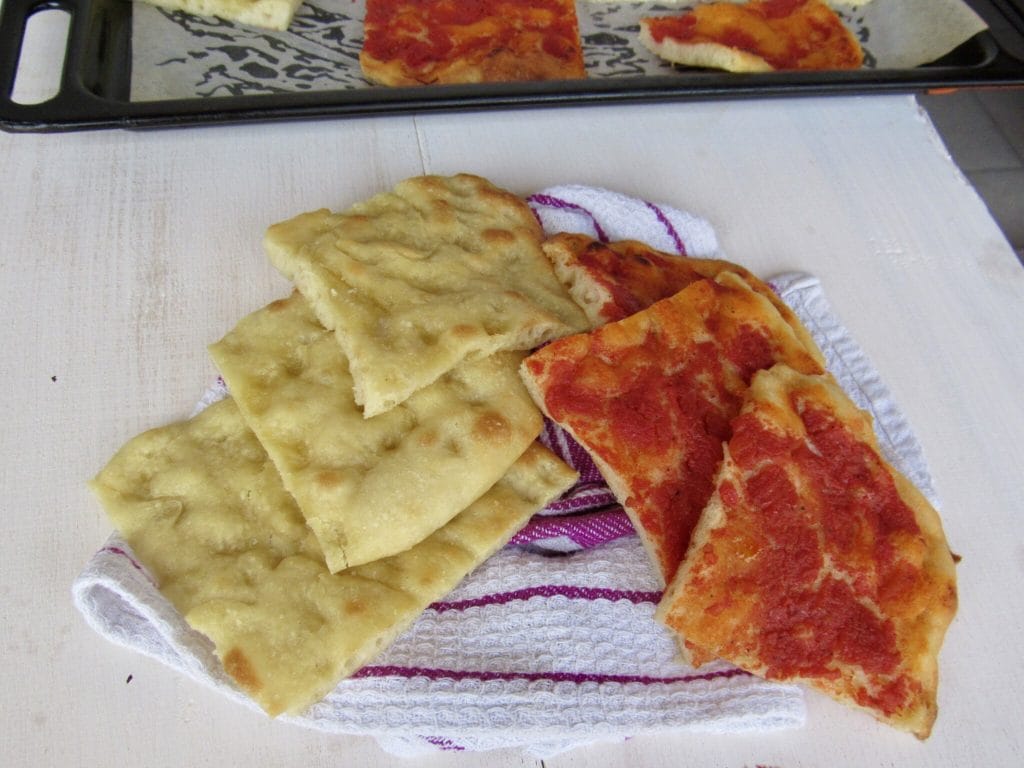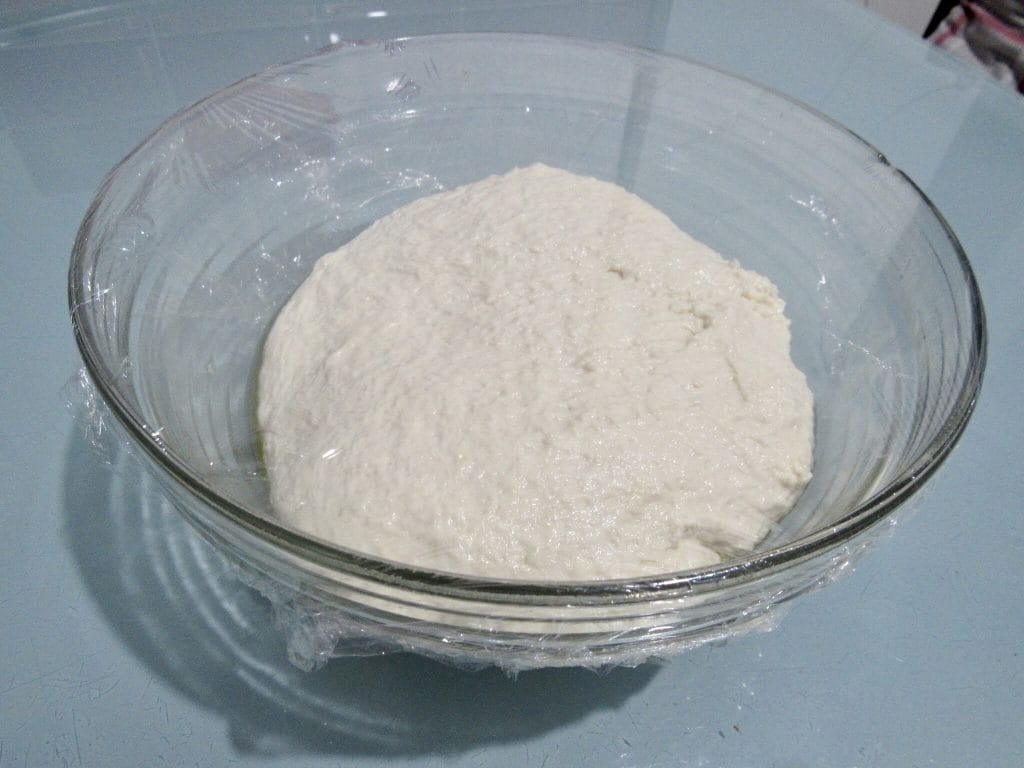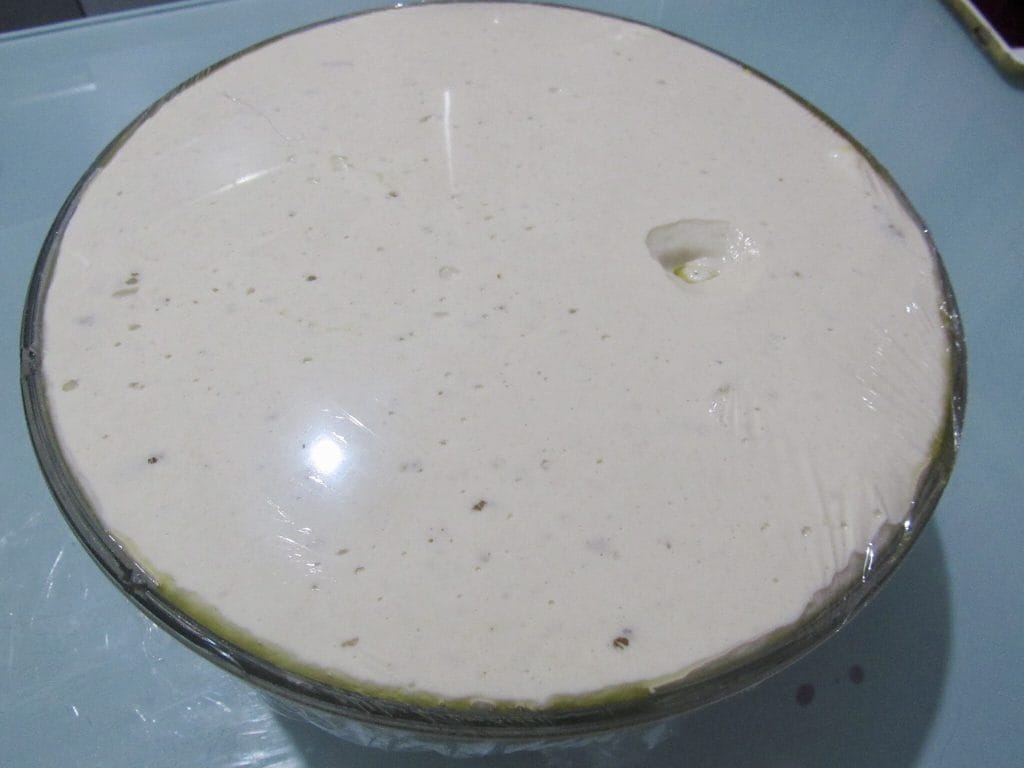Soft focaccia with sourdough. Tired of bringing the usual sandwiches to work, last night I decided to prepare a focaccia. I took the sourdough that I had refreshed in the morning and kneaded it. I made a focaccia with a very hydrated dough, so it came out soft as I like it. I spread it thin because I prefer it that way, but you can cover a single oven tray with this dough (I covered two) and you will have a thicker focaccia.
For those who don’t have sourdough, I also include the ingredients with yeast, but by using very few grams, the process doesn’t change. I kneaded the focaccia in the evening around 10:30 PM, spread it on the tray around 7 AM, and baked it at 9 AM. This is just to indicate my timing, but you can always adapt the fermentation to your schedule. If you want to bake it in the evening, just do the first fermentation in the fridge instead of at room temperature. However, remember that before working it, you should let it come to room temperature for half an hour, then spread it on the tray where it will remain for another couple of hours, and finally, you can bake it.
For those who love recipes with sourdough, here are some more, both savory and sweet

- Difficulty: Easy
- Cost: Economical
- Rest time: 11 Hours
- Preparation time: 10 Minutes
- Portions: 6
- Cooking methods: Oven
- Cuisine: Italian
- Energy 479.21 (Kcal)
- Carbohydrates 74.49 (g) of which sugars 2.08 (g)
- Proteins 11.40 (g)
- Fat 16.60 (g) of which saturated 2.21 (g)of which unsaturated 13.28 (g)
- Fibers 2.63 (g)
- Sodium 763.24 (mg)
Indicative values for a portion of 230 g processed in an automated way starting from the nutritional information available on the CREA* and FoodData Central** databases. It is not food and / or nutritional advice.
* CREATES Food and Nutrition Research Center: https://www.crea.gov.it/alimenti-e-nutrizione https://www.alimentinutrizione.it ** U.S. Department of Agriculture, Agricultural Research Service. FoodData Central, 2019. https://fdc.nal.usda.gov
Ingredients
- 14 oz all-purpose flour
- 3.5 oz durum wheat semolina
- 5 oz sourdough starter
- 1.5 cups water
- 1 tbsp olive oil
- 1 tsp honey
- 1.5 tsp salt
- 4 tbsps olive oil
- to taste salt
- 10.5 oz tomato pulp
- to taste salt
- to taste pepper
- 1 tbsp olive oil
Tools
To knead the focaccia I recommend using a stand mixer, for fermentation I recommend a glass bowl covered with plastic wrap.
- 1 Stand Mixer Howork
- 1 Bowl Pyrex
Preparation
Place the flours and the broken-up sourdough starter in the stand mixer bowl (for those using yeast, simply crumble it into the flours) and start at the lowest power. As the flours mix, gradually add the water, leaving some aside (as you might not need it all). Now add honey, salt, and oil, and mix at medium speed. If you can, slowly add all the water without making the dough too liquid. The dough should be soft and a bit sticky but not liquid.
Grease the glass bowl well and place all the dough inside. With a slightly oiled hand, fold the dough a bit over itself to form a sort of ball; cover the bowl with plastic wrap, ensuring it adheres well to the edges so no air enters. Let it rise.
At room temperature, at 7 AM, after about 9 hours, I found the dough risen. To extend the fermentation for personal reasons, just put the dough, still covered with plastic wrap, in the fridge and leave it until fully risen, then bring it to room temperature for at least half an hour and proceed as follows.

Pour the risen dough onto a slightly floured work surface and decide if you want two thinner focaccias like I did or one thicker focaccia. In the case of two focaccias, divide the dough in two and start spreading one at a time on a well-floured surface, helping with your fingers and turning it at least a couple of times on itself to facilitate spreading, then move it onto the baking tray covered with slightly oiled parchment paper and finish spreading the dough, always pressing with your fingertips on the dough, don’t use a rolling pin!
Let the spread dough rise, always covered with a cloth, for about two more hours or a little less, then season as desired. For the plain focaccia, I sprinkle with a little salt and add a drizzle of oil before and after baking.
For the red focaccia, season the tomato pulp with oil, salt, and pepper and pour it onto the pizza.
Bake the focaccias in a preheated oven one at a time as they need to rest directly on the bottom of the oven; if you have a baking stone, even better, but still directly in contact with the bottom of the oven. The oven should be heated to the maximum power, and your focaccias will cook in just a few minutes. As soon as the bottom of the pizza is cooked, you can remove it from the oven.

NOTES
My advice is to eat the focaccia immediately or within the day, but if you have some left for the next day, just warm it up with a toaster, and it will be as good as freshly baked.
This recipe contains one or more affiliate links.
If you liked the recipe or have any questions, feel free to comment here or on social media Facebook, Pinterest, Instagram and Twitter.

